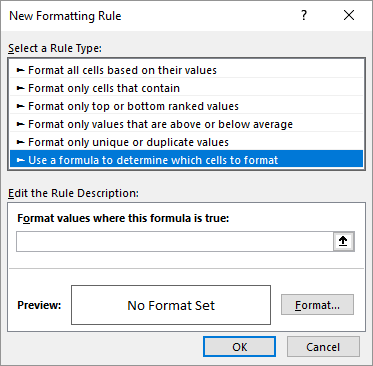Please Note: This article is written for users of the following Microsoft Excel versions: 2007, 2010, 2013, 2016, 2019, 2021, and Excel in Microsoft 365. If you are using an earlier version (Excel 2003 or earlier), this tip may not work for you. For a version of this tip written specifically for earlier versions of Excel, click here: Shading Based on Odds and Evens.
Written by Allen Wyatt (last updated November 10, 2025)
This tip applies to Excel 2007, 2010, 2013, 2016, 2019, 2021, and Excel in Microsoft 365
If you have a series of values in a range of cells, you might want to use different formatting to differentiate the odd numbers from the even numbers. The way you do this is through the use of the Conditional Formatting feature in Excel. Follow these steps:

Figure 1. The New Formatting Rule dialog box.
With this conditional formatting applied, if the cell is odd it will be one color and if even it will be another. If the cell contains text, the cell will be uncolored, meaning it will have the color of the cell before you added the conditional formatting. The conditional formatting overrides any formatting you put on the cell, so even if you try to change the cell color via the tools on the ribbons, the conditional formatting takes precedence.
The MOD function isn't the only thing you can use in your formula. If you want to determine whether the cell contains an odd value (step 6), you could use the following:
=ISODD(A1)
Similarly, if you want to determine if the cell contains an even value (step 11), you could use the following:
=ISEVEN(A1)
ExcelTips is your source for cost-effective Microsoft Excel training. This tip (6260) applies to Microsoft Excel 2007, 2010, 2013, 2016, 2019, 2021, and Excel in Microsoft 365. You can find a version of this tip for the older menu interface of Excel here: Shading Based on Odds and Evens.

Create Custom Apps with VBA! Discover how to extend the capabilities of Office 365 applications with VBA programming. Written in clear terms and understandable language, the book includes systematic tutorials and contains both intermediate and advanced content for experienced VB developers. Designed to be comprehensive, the book addresses not just one Office application, but the entire Office suite. Check out Mastering VBA for Microsoft Office 365 today!
If you have a data table in a worksheet, and you want to shade various rows based on whatever is in the first column, ...
Discover MoreIf you want to highlight cells that contain certain characters, you can use the conditional formatting features of Excel ...
Discover MoreNeed to conditionally highlight an entire row based on the contents of a single cell in each row? This tip explains how ...
Discover MoreFREE SERVICE: Get tips like this every week in ExcelTips, a free productivity newsletter. Enter your address and click "Subscribe."
2025-11-13 12:12:04
Mike J
The 2 methods described may produce different results if the list contains any non-integer numbers.
The MOD() method will not shade any non-integers, while the ISODD(), ISEVEN() method ignores fractional parts and therefore shades all numeric values, seemingly based on their rounded whole number values.
Got a version of Excel that uses the ribbon interface (Excel 2007 or later)? This site is for you! If you use an earlier version of Excel, visit our ExcelTips site focusing on the menu interface.
FREE SERVICE: Get tips like this every week in ExcelTips, a free productivity newsletter. Enter your address and click "Subscribe."
Copyright © 2026 Sharon Parq Associates, Inc.
Comments